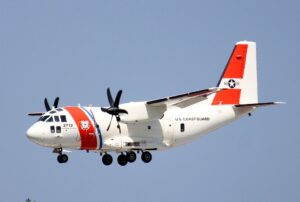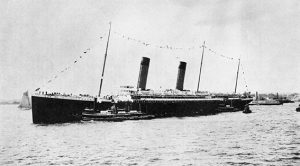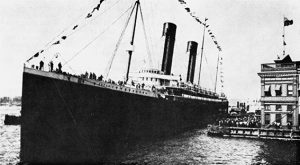Seven fishermen rescued by bulk carrier after their vessel caught fire
Just after midnight on Wednesday 10th November, several emergency beacon signals were received at the Eleventh Coast Guard District command center, from an 85-foot commercial fishing boat, the Blue Dragon. The vessel reported it was some some 350 miles west of Monterey, California, USA.

Immediately a CG C-27 Spartan aircraft was launched from Sacramento airbase; at the same time the Coast Guard notified the MV Nord Rubicon, which was in the vicinity of the boat in distress. The master diverted to assist in any rescue.
The C-27 arrived at the scene at 3.21am, and immediately radioed back that the fishing vessel was on fire, and that the crew were in a nearby life-raft. A second C-27 was launched from Sacramento at 8.00am to assist. The Reederei Nord bulk carrier Nord Rubicon arrived at 9.30am, and soon after rescued all seven crewmen. The bulk carrier then continued to San Francisco.


 Caribou was a Newfoundland Railway passenger ferry that ran from 1928 to 1942 between Port aux Basques, in what was then the Dominion of Newfoundland, and North Sydney in Nova Scotia. On 14th October 1942 the ferry was attacked and sunk by the German submarine U-69. She had women and children on board, many of whom were among the 137 who died, as well as Canadian, British and American military personnel. The ferry was part of a regular convoy that usually ran three-times a week, at night. The minesweeper HMCS Grandmère was the naval escort vessel. German submarine U-69 was in the Gulf of St Lawrence, seeking victims. At 3:51a.m. Newfoundland Summer Time, Caribou was torpedoed approximately 37 km (20 nmi) south-west of Port aux Basques and sank within five minutes. Grandmère dropped six depth charges, but U-69 escaped. Grandmère went back for survivors, then sailed for Sydney which had better hospital facilities.
Caribou was a Newfoundland Railway passenger ferry that ran from 1928 to 1942 between Port aux Basques, in what was then the Dominion of Newfoundland, and North Sydney in Nova Scotia. On 14th October 1942 the ferry was attacked and sunk by the German submarine U-69. She had women and children on board, many of whom were among the 137 who died, as well as Canadian, British and American military personnel. The ferry was part of a regular convoy that usually ran three-times a week, at night. The minesweeper HMCS Grandmère was the naval escort vessel. German submarine U-69 was in the Gulf of St Lawrence, seeking victims. At 3:51a.m. Newfoundland Summer Time, Caribou was torpedoed approximately 37 km (20 nmi) south-west of Port aux Basques and sank within five minutes. Grandmère dropped six depth charges, but U-69 escaped. Grandmère went back for survivors, then sailed for Sydney which had better hospital facilities. On board Caribou were 46 crew members and 191 civilian and military passengers. Captain Benjamin Taverner perished, along with his sons Stanley and Harold, who served as first and third officers. In total, 137 people died: 57 military personnel, 49 civilians and 31 crew died. Two female personnel were killed in the disaster: Bridget Fitzpatrick of the Newfoundland Merchant Navy, and Canadian Nursing Sister Agnes Wilkie: the only women in their respective services to be killed during the Second World War.
On board Caribou were 46 crew members and 191 civilian and military passengers. Captain Benjamin Taverner perished, along with his sons Stanley and Harold, who served as first and third officers. In total, 137 people died: 57 military personnel, 49 civilians and 31 crew died. Two female personnel were killed in the disaster: Bridget Fitzpatrick of the Newfoundland Merchant Navy, and Canadian Nursing Sister Agnes Wilkie: the only women in their respective services to be killed during the Second World War. The ferry had been built at the Adamson shipyard in Rotterdam for the Newfoundland Railway. She was launched on 9th June 1925 and made her maiden arrival at St John’s on 22nd October 1925. Caribou was able to reach a speed of 14.5 knot when fully loaded. She had steam-heat and electric lights in all cabins, considered to be a luxury at the time. With her ice-breaking design, Caribou also assisted during the seal hunt along the Newfoundland coast each spring.
The ferry had been built at the Adamson shipyard in Rotterdam for the Newfoundland Railway. She was launched on 9th June 1925 and made her maiden arrival at St John’s on 22nd October 1925. Caribou was able to reach a speed of 14.5 knot when fully loaded. She had steam-heat and electric lights in all cabins, considered to be a luxury at the time. With her ice-breaking design, Caribou also assisted during the seal hunt along the Newfoundland coast each spring. SS Flandre was built for CGT (French Line) by Atel. & Chant. de St Nazaire at Penhoet. Launched on 31st October 1913, she was transferred to Sud-Atlantique before completion for their Bordeaux to South America service. Her maiden voyage was on 30th September 1914, to Buenos Aires. Requisitioned in March 1915 she was used as a troopship in the Dardanelles campaign. In 1917 she was converted into a hospital ship, and after the Armistice was used to repatriate troops.
SS Flandre was built for CGT (French Line) by Atel. & Chant. de St Nazaire at Penhoet. Launched on 31st October 1913, she was transferred to Sud-Atlantique before completion for their Bordeaux to South America service. Her maiden voyage was on 30th September 1914, to Buenos Aires. Requisitioned in March 1915 she was used as a troopship in the Dardanelles campaign. In 1917 she was converted into a hospital ship, and after the Armistice was used to repatriate troops. In July 1919 Flandre was released and returned to CGT, for use on their Central American service to Mexico. During the Great Depression of the 1930s she was moved to the slower service operating from St Nazaire to Bordeaux, Spain and on to Central America and the West Indies.
In July 1919 Flandre was released and returned to CGT, for use on their Central American service to Mexico. During the Great Depression of the 1930s she was moved to the slower service operating from St Nazaire to Bordeaux, Spain and on to Central America and the West Indies. At the outbreak of World War II Flandre was initially laid up, but early in 1940 was requisitioned again, to transport troops for the Norway campaign. Following the collapse of France, Flandre was seized by the Germans for use as a naval auxiliary, to be used as a troop transport for Operation Sealion, the planned invasion of the UK. Leaving Bordeaux in convoy on 13th September 1940 she struck a magnetic mine, ironically laid earlier by Germans, in the mouth of the Gironde river, and grounded. She broke in two on 14th September 1940 and was abandoned, fortunately with no casualties. After the war the remains were destroyed by a Royal Navy ordnance team.
At the outbreak of World War II Flandre was initially laid up, but early in 1940 was requisitioned again, to transport troops for the Norway campaign. Following the collapse of France, Flandre was seized by the Germans for use as a naval auxiliary, to be used as a troop transport for Operation Sealion, the planned invasion of the UK. Leaving Bordeaux in convoy on 13th September 1940 she struck a magnetic mine, ironically laid earlier by Germans, in the mouth of the Gironde river, and grounded. She broke in two on 14th September 1940 and was abandoned, fortunately with no casualties. After the war the remains were destroyed by a Royal Navy ordnance team. Oceanic sailed from Liverpool on her maiden voyage on 6th September 1899, under Captain J.G. Cameron, with 1,456 passengers and 434 crew. However, because many of the replacement stokers were untrained, she made the crossing with the engines only generating about 75% of their potential and arrived at Sandy Hook on 15th September, docking just after noon. She had completed the crossing in 6 days 2 hours 27 minutes, at an average 19.57 knots.
Oceanic sailed from Liverpool on her maiden voyage on 6th September 1899, under Captain J.G. Cameron, with 1,456 passengers and 434 crew. However, because many of the replacement stokers were untrained, she made the crossing with the engines only generating about 75% of their potential and arrived at Sandy Hook on 15th September, docking just after noon. She had completed the crossing in 6 days 2 hours 27 minutes, at an average 19.57 knots. The channel for the approach to New York harbour was just 30 feet deep at the time. This meant that for some time Oceanic had to restrict the cargo she carried until Congress later supplied sufficient funds to enable the authorities to dredge the channel deeper, to at least 35 feet, more in places.
The channel for the approach to New York harbour was just 30 feet deep at the time. This meant that for some time Oceanic had to restrict the cargo she carried until Congress later supplied sufficient funds to enable the authorities to dredge the channel deeper, to at least 35 feet, more in places. On 24th July 1940 the French liner Meknes was repatriating French servicemen from Southampton to Marseilles when she was spotted off the English coast by a German E-boat, the S-27. Although the Vichy French government had been informed that Frenchmen were aboard, the German naval authorities had apparently not been informed. Meknes, brightly lit and with a large French flag painted on her sides, stopped and attempted to identify herself to the German vessel. However around 10.30pm the E-boat opened fire with machine-guns and then fired a torpedo into the liner. Meknes sank within ten minutes. There were over 1200 men aboard, and nearly 400 died – exact figures were never released.
On 24th July 1940 the French liner Meknes was repatriating French servicemen from Southampton to Marseilles when she was spotted off the English coast by a German E-boat, the S-27. Although the Vichy French government had been informed that Frenchmen were aboard, the German naval authorities had apparently not been informed. Meknes, brightly lit and with a large French flag painted on her sides, stopped and attempted to identify herself to the German vessel. However around 10.30pm the E-boat opened fire with machine-guns and then fired a torpedo into the liner. Meknes sank within ten minutes. There were over 1200 men aboard, and nearly 400 died – exact figures were never released. The Vichy French government had insisted that all French servicemen in Britain should be repatriated, since France had surrendered and was no longer at war with Germany. Only those men that had already volunteered to serve with the Free French Forces were to be permitted to stay. A number of vessels were allotted to repatriate the returning Frenchmen.
The Vichy French government had insisted that all French servicemen in Britain should be repatriated, since France had surrendered and was no longer at war with Germany. Only those men that had already volunteered to serve with the Free French Forces were to be permitted to stay. A number of vessels were allotted to repatriate the returning Frenchmen. Built by Chanters et Atlier de St Nazaire, Grand Quevilly, she was a 6,757grt twin-propeller vessel with a service speed of 14.5 knots, and accommodation for 112 in First Class, 32 in Second and 406 in Third. She was originally named Puerto Rico, but was renamed Meknes in 1929, although still operating for CGT. Her peacetime route was from Bordeaux to Casablanca.
Built by Chanters et Atlier de St Nazaire, Grand Quevilly, she was a 6,757grt twin-propeller vessel with a service speed of 14.5 knots, and accommodation for 112 in First Class, 32 in Second and 406 in Third. She was originally named Puerto Rico, but was renamed Meknes in 1929, although still operating for CGT. Her peacetime route was from Bordeaux to Casablanca.